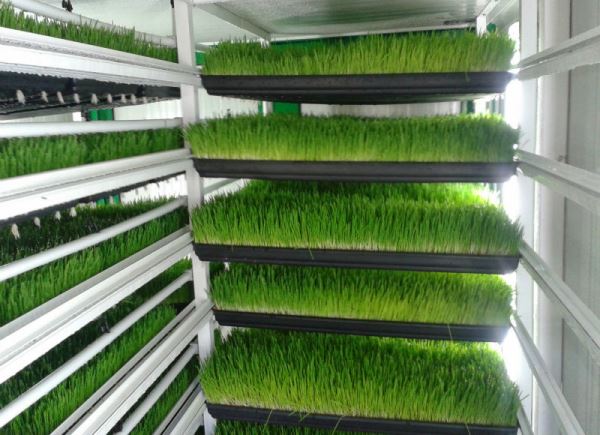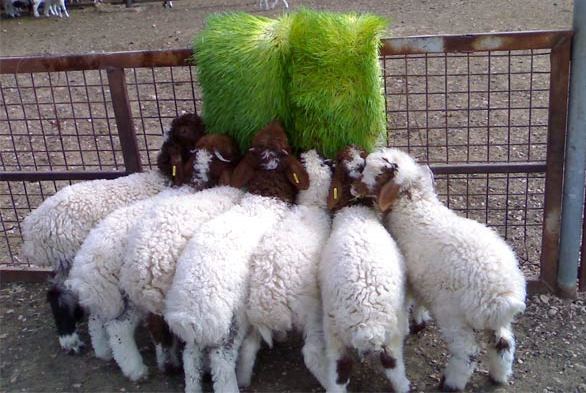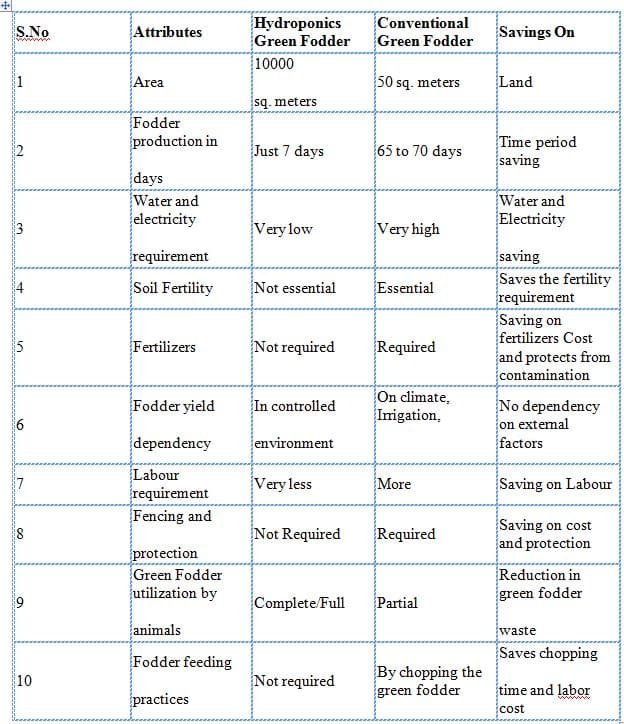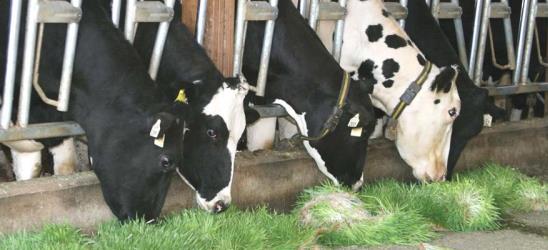Hydroponic Green Fodder Details
The following write up explains about hydroponic green fodder production.

Introduction of Hydroponic Green Fodder:
Green fodder is one of the important inputs and plays a major role in the feed of milch animals. Green fodder provides required nutrients/mineral for milk production and health of the dairy animals or livestock. Control of feed cost in dairy animals impacts the profits and result in successful dairy farming. Generally, in most of the Indian states, the feed cost is about 70 to 75% of total milk cost wherein green fodder contributes 30 to 35% of total input feed. In India, rapid urbanization and mining areas have caused shrinkage of grazing areas and availability of lands that produce green fodder. This situation caused the dairy owners to look for an alternative and sustainable method of quality green fodder production. Due to high labor costs, non-availability of irrigated lands and high land prices made the dairy business to face many challenges to meet the growing milk demand in the country. It is very clear that with increasing costs and depleting natural resources, sustainable technology like ‘Hydroponics’ would be the key driver of the dairy industry future. Using hydroponic technology to produce the quality green fodder would be a revolutionary step in the country’s green fodder production. Having limited irrigation facility is also forces to implement the hydroponic technology in the production of green fodder. Greenhouse / Polyhouse would be the right choice for implementing hydroponic technology. Many states in India are providing subsidies for building polyhouse and greenhouses. One can avail these subsidies on greenhouse or polyhouse to implement the hydroponic technology in the production of quality green fodder. Hydroponically grown fodder can be fed to sheep, goat, cattle and other livestock animals.
Need for Hydroponic Technology:
Hydroponics technology is required to overcome the following constraints for the production of quality green fodder in India, especially in dairy farmers.
- In the case of small land holdings.
- In case of non-availability of fertile lands for green fodder cultivation.
- When the irrigation/water facility, fencing, land preparations resources/labor are limited.
- In mining and coastal belt areas where it has limited area for growing green fodder dairy industry.
- In areas, where destruction of fodder is caused by stray cattle’s and other wild animals.
- In regions, where dairy farmers spend a higher cost for labor for green fodder cultivation.
- In areas, where poor participation of educated unemployed youths for green fodder production.
- In regions, where the demand for green fodder is very high against the existing availability of the fodder.

Read: Rabbit Fattening Feed.
About Hydroponic Technology:
What is hydroponics? Well, hydroponics is a scientific way of growing plants/crops in water without any soil in a controlled environment. In hydroponic technology, water is enriched with well-balanced nutrients which are essential for plants growth and better yield. When it comes to green fodder production, hydroponic technology takes the pressure off the land to grow green fodder for the livestock/animals. Generally, water, nutrients, and sunlight are major inputs to the hydroponic system. Using, hydroponic system, fodder crops like Barley, Oats, Maize, and Sorghum can be cultivated for producing high quality of nutritious green fodder for livestock/ dairy animals. Hydroponic green fodder results in good health of dairy animals apart from high dairy yield. Apart from this, the hydroponics system can be used for growing wheatgrass, paddy saplings in 7 to 10 days of time for optimum growth of the crop. Green fodder obtained from hydroponics consists of grass with grains, roots, stem, and leaves. Whereas conventionally grown fodder consists of a stem and leaves only.

Using Hydroponics in Dairy/Livestock Business:
Why the hydroponic green fodder plays a major role in dairy business?.
- The hydroponic system allows growing green fodder at a wider temperature in the range of 15-33 and humidity range at 70-80 % without fungal growth.
- Hydroponic technology is environmentally friendly.
- Hydroponically grown fodder is free from contamination.
- Hydroponically grown green fodder saves water and labor cost.
- Hydroponically grown fodder is highly nutritious.
- The green fodder from the hydroponic system improves animal/livestock health and reproductive efficiency.
- Feeding highly nutritious fodder will result in higher milk yield in dairy animals.
- Cost control can be achieved by growing green fodder in the hydroponic system which leads to profitable and successful dairy farming.
Read: Aloe Vera Juice Extraction Process.
Benefits and Advantages of Hydroponics:
There are many advantages of hydroponic farming especially growing green fodder.
- Water Saving: The hydroponic system requires only 2 to 3 liters of water to grow 1 kg of quality green fodder when compared to 55 to 75 liters of water used in conventional/traditional system of green fodder production. Apart from this advantage, there will not be any water wastage as the water is always recycled.
- Utilization of Minimal Land: Generally, hydroponic greenhouse requires marginal land to cover the area of 10 meters x 5 meters for 600 to 650 kg of green fodder per day per unit. To produce the same amount of green fodder in a conventional green grass field, it requires 1-hectare land. This is very useful where procuring an irrigated land is difficult and green fodder demand is very high.
- Less Labour Requirement: In hydroponics, the labor required for green fodder production is about 2 to 3 hours a day whereas conventional fodder production system requires continuous intense labor for cultivation to the harvesting of the grass.
- Less Time to Grow Green Fodder: To get the optimal growth stage of nutritious green fodder, it requires just over 7 to 8 days from seed germination to fully grown plant of 20 – 30 cm height. In hydroponically grown fodder, the biomass conversion ratio is as high as 6-7 times to traditional fodder grown for 65-80 days.
- Round the Year Production: Constant supply of green fodder is possible around the year to meet the dairy industry demand.
- Increased Nutritious Value: The green fodder grown from the hydroponic system will be highly Nutritious as compared to conventionally grown fodder. So using, hydroponic grass, one can supply quality milk from dairy animals.
- Natural Green Fodder Supply: Production of green fodder through Hydroponic technology is completely by a natural source and no pesticides are used in green fodder production that could contaminate milk and milk products.
- Minimal Loss of Green Fodder: Green fodder grown from the hydroponic system will be fully utilized as there won’t be any loss of the green fodder during feeding. There would be wastage of chopped traditional green fodder or green grasses during consumption by the animal.
- Faster Growth and High Yield: Finally, the hydroponic system proves that it can produce the green fodder at the faster growth rate and result in high yield of fodder as compared to conventional green grass/ fodder production.
Important Tips for Green Fodder Production in Hydroponics:
The following are some tips in greenhouse hydroponic green fodder production.
- In order to avoid fungal growth in the greenhouses fungicidal solution like EM (Effective microorganism) to be applied.
- White maize/corn seed was found to have a better germination rate when compared to yellow maize.
- It is important that the water in the greenhouse tank should be replaced in every 3 days.
- Selection of seeds should be free from impurities to avoid clogging of foggers to produce quality feed.
- Generally, green fodder leaves will become yellow due to excessive sunlight outside of the greenhouse.
Comparison Table for Hydroponic Green Fodder Production vs. Conventional Green Fodder Production:
The following table lists out the main differences between maize (corn) hydroponic green fodder production and conventional maize green fodder production.

Bottom Line:
As land prices are going up, irrigated lands and fertile lands are limited, to meet the dairy animal industry demand for green fodder forces to implement the sustainable method of growing fodder using hydroponics technology. This technology would be the backbone for the dairy industry in the coming days. This technology also provides quality milk products and helps the Indian economy.
Read: How to Make Liquid Fertilizers at Home.

please help me in the sheeps goats, poultry subject
For Poultry farming Read this: http://www.asiafarming.com/poultry-farming-information-guide/
For Sheep Farming Read this: http://www.sheepfarm.in
For Goat Farming: Read this: http://www.goatfarming.in
Hi,
do you also help in setting up hydroponic farms.
We don’t set up any hydroponic farms. There are people who can sell you hydroponic kits and help in setting. Talk to somebody at futurefarms dot in.
Please send me details on Hydroponic Technology and the source .
Is there any study/data on how much is the cost for green grass produced by hydroponics per kilo.
We will update about Hydroponic Grass Project Report soon.
Thanks Agrifarming for all your services to Agriculture.
It will be very good and useful if you can upload cost incurred to start hydroponic green fodder and also if you can upload some videos as well.
We will be updating soon with Hydroponic Green Fodder Cost and Profit information along with Project report.
Thanks agrifarming for all services
Please tell me about the dry material efficiency ( output/input ratio) in hydroponic green fodder production, specially in barley anodized corn. Apart , how about of mechanical harvesting of yield?
Hydroponic technology needs sunlight or any specific temperature because in my hometown approx 24°C to 44°C. Please reply me it’s possible to grow hydroponically?
Please Give 1 Bigha Cost of Hydroponic System
Check this: Hydroponics Farming Cost and Profit.
I more eager to know, is there any minerals, nutrients, fertilizer is used for hydroponic green fodders.
hello sir,
My name is Jigar Patel. By Professionally I am an Master of Chemical Engineer. Just now I am working in Project.
But I want to start Gaushala within a year.
Due to this reason I want to need more grass to require. I also maintain organic grass quality.
Is it possible to develop grass in an organic way with hydroponic green fodder?
Kindly reply in the mail to me and what is the cost, also manpower requirement during this process.
Your early reply is highly appreciated.
Thanks for sharing good information on Google.
Warm Regards,
Jigar Patel